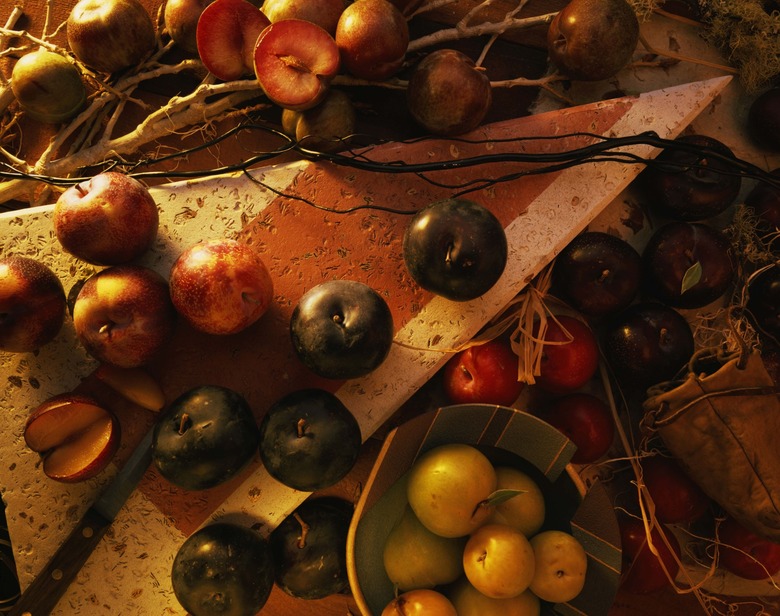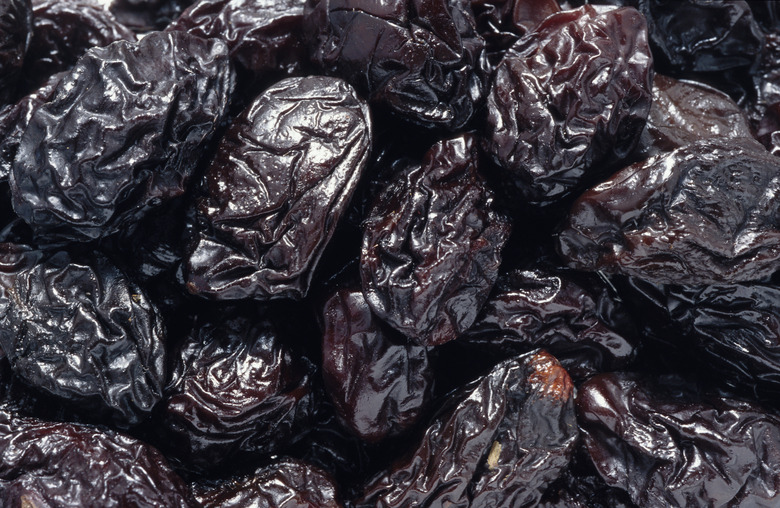California Plum Varieties
California produces over 90 percent of all plums grown in the United States. According to the University of California Davis, approximately 250 varieties of plums grow here. These varieties are divided into two main categories: Japanese and European. The plum, a member of the rose family, originated in China, but was domesticated in Japan about 400 years ago to become the Japanese variety we know today. In California, plums are an important fresh fruit crop.
Yellow Plums
The Shiro is a Japanese type plum favored by California growers. It is one of several varieties of yellow plums that are found in California orchards. Moderate in size, its yellow skin is blushed with pink. The flesh is juicy and sweet, but tart at the pit. Although many plums are freestone, this is a clingstone plum. According to Jim Kratz at Tuscola Conservation District's U. S. Department of Agriculture Service Center, the Shiro plum is one of the best plums available. Other yellow plums include the Early Golden — an extremely sweet and juicy variety — the Golden Nectar and the Mirabelle. The Mirabelle is a small European-type plum. The skin is yellow and crisp, the flesh sweet and juicy. The Mirabelle is also a favorite in California.
- California produces over 90 percent of all plums grown in the United States.
- The Shiro is a Japanese type plum favored by California growers.
Old Varieties Popular Today
The Santa Rosa plum is an old stand-by and a favorite of California growers. Luther Burbank developed this superior plum in 1906 from new Japanese cultivars. He named the plum in honor of his gardens in Santa Rosa, California. A shiny, ruby red plum, the Santa Rosa makes up 30 percent of the country's total plum crop. Other still-popular old varieties are the Damson and the Old English Greengage, both are European varieties. The Damson's origin is the Black Sea area. A tart fruit, it is better for cooking and preserving than to eat out of hand. The Greengage is a juicy, dessert fruit.
- The Santa Rosa plum is an old stand-by and a favorite of California growers.
Varieties of Black Plums
There a several varieties of black plums. Among them are the Friar, the Black Beauty and the Black Splendor. The Friar is an older but still popular black plum. Friars are a dessert plum, good eaten out of hand. The flesh is creamy yellow and fairly firm, the pit is small. Its skin is smooth and shiny. When fully ripe, the Friar is a deep black in color. The Black Beauty is also a good-quality plum. Its slightly soft flesh is amber tinged with red. The skin is purple-black when ripe. A fairly new variety, the Black Splendor is big, sweet and very juicy. It has black skin with a hint of mahogany at the shoulders. The flesh is beet red. According to the USDA Agricultural Research Service, the Black Splendor plum is an early variety, commanding the early season's higher prices, but for its excellent flavor the extra cost is nominal.
- There a several varieties of black plums.
- A fairly new variety, the Black Splendor is big, sweet and very juicy.
The Prune Plum
Growers are constantly experimenting with new varieties, but few of these plums are deemed viable for marketing — the California Improved French prune-plum being an exception. This newer variety of the European (French) plum is far superior to other prune-plums. They are sweeter — a requirement for fruit used for drying — and more disease resistant than many other plums. The Improved French is currently the most popular prune-plum of California growers. It occupies 98 percent of the total dried-plum acreage in the state. According to researchers at University of California at Davis, a new cultivar, the Honey Sweet, is even more disease resistant, and very sweet, but it is a fresh-market plum, not suitable for California dried-plum production.

